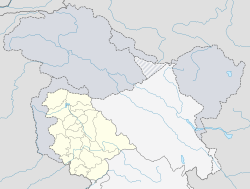बाइंथा ब्राक इन्हें भी देखें सन्दर्भ दिक्चालन सूची35°56′52″N 75°45′13″E / 35.94778°N 75.75361°E / 35.94778; 75.7536135°56′52″N 75°45′13″E / 35.94778°N 75.75361°E / 35.94778; 75.75361"Karakoram ultra-prominent peaks"
सात हज़ारीकाराकोरमगिलगित-बल्तिस्तान के पर्वत
काराकोरम पर्वतमालापनमाह मुज़ताग़पर्वतविश्व का 87वाँ सर्वोच्च पर्वतपाक-अधिकृत कश्मीरगिलगित-बल्तिस्तानभारतसम्प्रभुताजम्मू और कश्मीरबियाफ़ो हिमानी
| बाइंथा ब्राक | |
|---|---|
| दानव Baintha Brakk / The Ogre | |
 लटोक पर्वतों और दानव के अंगूठा नामक स्थलाकृति का दृश्य | |
| उच्चतम बिंदु | |
| ऊँचाई | 7,285 मी॰ (23,901 फीट) 87वाँ सर्वोच्च |
| उदग्रता | 1,891 मी॰ (6,204 फीट) [1] |
| सूचीयन | चरम उदग्र शिखर |
| निर्देशांक | 35°56′52″N 75°45′13″E / 35.94778°N 75.75361°E / 35.94778; 75.75361निर्देशांक: 35°56′52″N 75°45′13″E / 35.94778°N 75.75361°E / 35.94778; 75.75361 |
| भूगोल | |
 बाइंथा ब्राक पाक-अधिकृत कश्मीर में स्थिति | |
| अवस्थिति | गिलगित-बल्तिस्तान, पाक-अधिकृत कश्मीर[2] |
| मातृ श्रेणी | पनमाह मुज़ताग़, काराकोरम |
| आरोहण | |
| प्रथम आरोहण | जुलाई 13, 1977 |
| सरलतम मार्ग | हिम व बर्फ़ पर चढ़ाई |
बाइंथा ब्राक (Baintha Brakk), जिसे दानव (The Ogre, द ओगर) भी कहा जाता है, काराकोरम पर्वतमाला की पनमाह मुज़ताग़ उपश्रेणी का सबसे ऊँचा पर्वत है और विश्व का 87वाँ सर्वोच्च पर्वत भी है। यह पाक-अधिकृत कश्मीर के गिलगित-बल्तिस्तान क्षेत्र में है जिसपर भारत अपनी सम्प्रभुता और अपने जम्मू और कश्मीर राज्य का अंग होने का दावा करता है। यह एक तीखी ढलान और पत्थरीली चट्टानों वाला पर्वत है जिसे चढ़ना बहुत कठिन माना जाता है। यह बियाफ़ो हिमानी की उत्तरी तरफ़ खड़ा हुआ है।[3]
इन्हें भी देखें
- पनमाह मुज़ताग़
- बियाफ़ो हिमानी
- विश्व के सर्वोच्च पर्वत
सन्दर्भ
↑ "Karakoram ultra-prominent peaks". peaklist.org. अभिगमन तिथि 2013-07-27..mw-parser-output cite.citationfont-style:inherit.mw-parser-output qquotes:"""""""'""'".mw-parser-output code.cs1-codecolor:inherit;background:inherit;border:inherit;padding:inherit.mw-parser-output .cs1-lock-free abackground:url("//upload.wikimedia.org/wikipedia/commons/thumb/6/65/Lock-green.svg/9px-Lock-green.svg.png")no-repeat;background-position:right .1em center.mw-parser-output .cs1-lock-limited a,.mw-parser-output .cs1-lock-registration abackground:url("//upload.wikimedia.org/wikipedia/commons/thumb/d/d6/Lock-gray-alt-2.svg/9px-Lock-gray-alt-2.svg.png")no-repeat;background-position:right .1em center.mw-parser-output .cs1-lock-subscription abackground:url("//upload.wikimedia.org/wikipedia/commons/thumb/a/aa/Lock-red-alt-2.svg/9px-Lock-red-alt-2.svg.png")no-repeat;background-position:right .1em center.mw-parser-output .cs1-subscription,.mw-parser-output .cs1-registrationcolor:#555.mw-parser-output .cs1-subscription span,.mw-parser-output .cs1-registration spanborder-bottom:1px dotted;cursor:help.mw-parser-output .cs1-hidden-errordisplay:none;font-size:100%.mw-parser-output .cs1-visible-errorfont-size:100%.mw-parser-output .cs1-subscription,.mw-parser-output .cs1-registration,.mw-parser-output .cs1-formatfont-size:95%.mw-parser-output .cs1-kern-left,.mw-parser-output .cs1-kern-wl-leftpadding-left:0.2em.mw-parser-output .cs1-kern-right,.mw-parser-output .cs1-kern-wl-rightpadding-right:0.2em
↑ This region is disputed, and is claimed by India to be an integral part of the Indian state of Jammu and Kashmir.
↑ Jill Neate, High Asia: An Illustrated History of the 7000 Metre Peaks, ISBN 0-89886-238-8.